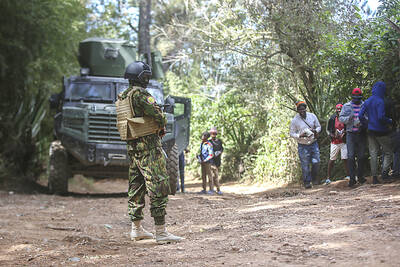Egypt and Germany have been fighting for possession of her for 90 years but, because Adolf Hitler loved her, she remained in Berlin's Egyptian art museum.
In a dispute as old as the land of the Nile itself, Egypt has repeatedly reasserted its claim to the wayward beauty it says is being held illegally in Berlin.
The wayward beauty is one of the great masterpieces of Ancient Egyptian art -- the 3,300-year-old bust of 18th Dynasty Queen Nefertiti. Now she is on the move again. She will not be going home to Egypt. Instead, she will be moving across town to new digs, relinquishing her pedestal in a converted guard house in what used to be West Berlin for more royal surroundings in the heart of reunited Berlin.
The wounds of post-war division are finally healing over, and the German capital's Egyptian art collection, one of the finest outside Egypt itself, is being brought back together at long last.
The painted limestone and plaster bust, depicting the elegantly chiselled life-sized features of a stunningly beautiful woman wearing a unique cone-shaped headdress, has formed the cornerstone of Berlin's Egyptian collection since German archeologists discovered the bust in the ruins of an ancient artist's studio on the banks of the Nile in 1912.
The collection initially was housed at the Neues Museum (New Museum) just a few meters from the Hohenzollern Palace in the heart of Berlin. Reflecting the fashion of the times, the museum itself was done up inside to resemble an Ancient Egyptian temple, complete with hieroglyphic inscriptions on the walls.
But as bombs rained down on Berlin during World War II, curators hastily stashed the city's art treasures at warehouses outside the city. After the war, some of those warehouses turned out to be in East Germany, and others in West Germany.
Nefertiti ended up in the west and took up residency in West Berlin's makeshift Egyptian museum in a converted guard house across the street from Charlottenburg Palace. But the bulk of the Berlin Egyptian collection remained in the east, and was on view at the Bode Museum in East Berlin until the Berlin Wall came down.
Since then, the city has been working to renovate and, in some cases, rebuild the 19th Century museum complex that once graced the center of this city.
Around the middle of the year, work will have progressed enough that the Egyptian collection will be able to be reunited under one roof for the first time since the war.
Nefertiti will be removed from the converted guard house on March 2 to take up temporary residence at the Kultur Forum exhibition hall at Potsdamer Platz in the revivified centre of Berlin. There, she will form the focal point of a six-month exhibit on Egyptian hieroglyphs and their influence on art up to the modern day.
If all goes according to plan, Nefertiti will be able to move into the newly rebuilt but anachronistically named Altes Museum (Old Museum).
But even the Altes Museum is only temporary lodgings for her. Her original digs in the nearby Neues Museum will be ready by 2008 or 2009, thus bringing her back home again.
An alluring mystery has surrounded the bust since its discovery on Dec. 7, 1912, incredibly intact and sporting vibrant colors, after lying in forgotten in the sands since the tumultuous days at the close of the reign of Pharaoh Akhenaton, one of the most enigmatic rulers of all time.
In 1913, the Ottoman Empire agreed to allow its finder, part-time German-Jewish archeologist and full-time entrepreneur James Simon, to retain possession of the bust.
Simon carted it off to Europe and displayed Nefertiti prominently displayed in his home in Berlin before later lending it to the Berlin museum and finally donating it in 1920 to the Berlin collection.
In 1933 the Egyptian government demanded Nefertiti's return -- the first of many such demands over the decades to come. One of the many titles Hermann Goering held was premier of Prussia (which included Berlin) and, acting in that capacity, Goering suggested to King Fouad I of Egypt that Nefertiti would soon be back in Cairo.
But Hitler had other plans. Through the ambassador to Egypt, Eberhard von Stohrer, Hitler informed the Egyptian government that he was an ardent fan of Nefertiti: "I know this famous bust," the fuehrer wrote. "I have viewed it and marvelled at it many times. Nefertiti continually delights me. The bust is a unique masterpiece, an ornament, a true treasure!"
Hitler said Nefertiti had a place in his dreams of rebuilding Berlin and renaming it Germania.
"Do you know what I'm going to do one day? I'm going to build a new Egyptian museum in Berlin," Hitler went on. "I dream of it. Inside I will build a chamber, crowned by a large dome. In the middle, this wonder, Nefertiti, will be enthroned. I will never relinquish the head of the Queen."
Hitler and his mad dreams are long dead. But Nefertiti continues to smile serenely. As she has for 3,300 years. As if to say, this too shall pass. And I shall endure.

DEATH CONSTANTLY LOOMING: Decades of detention took a major toll on Iwao Hakamada’s mental health, his lawyers describing him as ‘living in a world of fantasy’ A Japanese man wrongly convicted of murder who was the world’s longest-serving death row inmate has been awarded US$1.44 million in compensation, an official said yesterday. The payout represents ¥12,500 (US$83) for each day of the more than four decades that Iwao Hakamada spent in detention, most of it on death row when each day could have been his last. It is a record for compensation of this kind, Japanese media said. The former boxer, now 89, was exonerated last year of a 1966 quadruple murder after a tireless campaign by his sister and others. The case sparked scrutiny of the justice system in

A French-Algerian man went on trial in France on Monday for burning to death his wife in 2021, a case that shocked the public and sparked heavy criticism of police for failing to take adequate measures to protect her. Mounir Boutaa, now 48, stalked his Algerian-born wife Chahinez Daoud following their separation, and even bought a van he parked outside her house near Bordeaux in southwestern France, which he used to watch her without being detected. On May 4, 2021, he attacked her in the street, shot her in both legs, poured gasoline on her and set her on fire. A neighbor hearing

DITCH TACTICS: Kenyan officers were on their way to rescue Haitian police stuck in a ditch suspected to have been deliberately dug by Haitian gang members A Kenyan policeman deployed in Haiti has gone missing after violent gangs attacked a group of officers on a rescue mission, a UN-backed multinational security mission said in a statement yesterday. The Kenyan officers on Tuesday were on their way to rescue Haitian police stuck in a ditch “suspected to have been deliberately dug by gangs,” the statement said, adding that “specialized teams have been deployed” to search for the missing officer. Local media outlets in Haiti reported that the officer had been killed and videos of a lifeless man clothed in Kenyan uniform were shared on social media. Gang violence has left

‘HUMAN NEGLIGENCE’: The fire is believed to have been caused by someone who was visiting an ancestral grave and accidentally started the blaze, the acting president said Deadly wildfires in South Korea worsened overnight, officials said yesterday, as dry, windy weather hampered efforts to contain one of the nation’s worst-ever fire outbreaks. More than a dozen different blazes broke out over the weekend, with Acting South Korean Interior and Safety Minister Ko Ki-dong reporting thousands of hectares burned and four people killed. “The wildfires have so far affected about 14,694 hectares, with damage continuing to grow,” Ko said. The extent of damage would make the fires collectively the third-largest in South Korea’s history. The largest was an April 2000 blaze that scorched 23,913 hectares across the east coast. More than 3,000